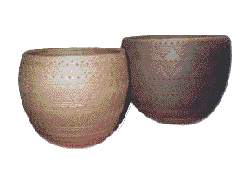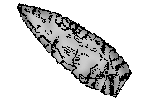 About five thousand years ago, a bay full of islands billowed at
the present lower course of the Aura River. The coast-line was located at about
Nautelankoski. The food-gathering and fish-catching population of that time lived on the
coast in sheltered bays and on island beaches.
About five thousand years ago, a bay full of islands billowed at
the present lower course of the Aura River. The coast-line was located at about
Nautelankoski. The food-gathering and fish-catching population of that time lived on the
coast in sheltered bays and on island beaches.
The Kukkarkoski Stone Age settlement site and cemetery, found on the east bank of Nautelankoski, is regarded as one of the most significant sites in Finland. The name comes from the older name of Nautelankoski, Kukkarkoski. The area has been researched in 1958 and 1975-76. The extensive settlement zone and cemetery are a proof of a lengthy Stone Age settlement period, about 3500- 2500 B.C.
 Typical for the times, the settlement site was located right on the sea
shore. There were good connections to fishing areas, and the rivers flowing nearby offered
a route to hunting grounds located further away from the coast. In the cemetery located
above the settlement site, 12 graves have been studied. Most of them were covered with red
ochre. The finds of the cemetery and settlement comprise pieces of clay pots, arrow-heads
and knives made of flintstone and quartz, celts, and ornaments made of amber. Flint, or
chert, and amber being found in the graves refer to trade connections to the east and
south. The Kukkarkoski findings are dated in both the Comb-Ceramic and the subsequent
Battle-Ax culture (approx. 2500-2000 B.C.).
Typical for the times, the settlement site was located right on the sea
shore. There were good connections to fishing areas, and the rivers flowing nearby offered
a route to hunting grounds located further away from the coast. In the cemetery located
above the settlement site, 12 graves have been studied. Most of them were covered with red
ochre. The finds of the cemetery and settlement comprise pieces of clay pots, arrow-heads
and knives made of flintstone and quartz, celts, and ornaments made of amber. Flint, or
chert, and amber being found in the graves refer to trade connections to the east and
south. The Kukkarkoski findings are dated in both the Comb-Ceramic and the subsequent
Battle-Ax culture (approx. 2500-2000 B.C.).
The exhibition is being put togeter by Kaisa Lehtonen, archaeologist.
The area is protected by the law on relics of antiquity (295/63).